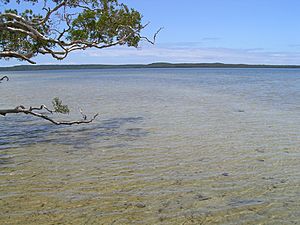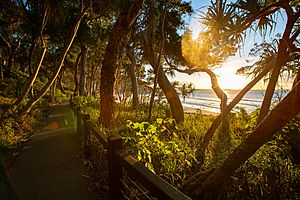Noosa National Park facts for kids
Quick facts for kids Noosa National ParkQueensland |
|
|---|---|
|
IUCN Category II (National Park)
|
|

A beach on the headlands coastal trail
|
|
| Established | 1939 |
| Area | 4,000 ha (15.44 sq mi) |
| Visitation | 1 million (in 2009) |
| Managing authorities | Queensland Parks and Wildlife Service |
| Website | Noosa National Park |
| See also | Protected areas of Queensland |
Noosa National Park is a beautiful natural area in Queensland, Australia. It's about 121 kilometers (75 miles) north of Brisbane. This park is located near Noosa Heads, right between the Pacific Ocean and the busy Sunshine Coast. It stretches south past Lake Weyba all the way to Coolum Beach.
Contents
Exploring Noosa National Park
Noosa National Park covers a large area of 4,000 hectares (about 9,884 acres). It's divided into four main parts: the Headland Section, Peregian Section, Emu Mountain Section, and East Weyba Section. This park is super popular, with over 1 million people visiting it every year!
Fun Activities in the Park
You can find several beaches inside the park that are great for swimming. Just remember, these beaches don't have lifeguards, so be careful of strong currents, especially at Alexandria Bay.
Besides swimming, you can also enjoy rock climbing, fishing, surfing, and snorkeling. It's important to know that camping is not allowed anywhere in the park.
History of the Park
The story of Noosa National Park began a long time ago. Early settlers in Noosa Heads decided to protect this special area in 1879. It officially became a national park in 1939.
Protecting the Wilderness
In the early 1960s, people became very active in protecting the park. A group called the Noosa Parks Association was formed. This was important because new buildings and towns were starting to threaten the wild areas of the park.
A plan for how to manage the park was created in October 1999. Later, in 2003, an extra 300 hectares (about 741 acres) of land near Coolum were added to the park, making it even bigger.
Amazing Plants of Noosa National Park
The Headland Section of the park has small areas of rainforest. Here, you'll see tall hoop pines and kauri pines. There are also open eucalypt forests and areas with wallum heaths, pandanus palms, and grasslands.
Wildflowers and Orchids
The Peregian Section of the park is famous for its beautiful wildflowers. They bloom especially well in spring. Keep an eye out for the rare swamp orchid and the colorful Christmas bells.
Animals of Noosa National Park
Noosa National Park is home to many amazing animals. You might spot koalas living in the trees! Other mammals found here include the short-nosed bandicoot, common ringtail possum, and brushtail possum.
Birds and Whales
Many different birds live in the park's forests. These include the eastern ground parrot, glossy black cockatoo, eastern yellow robin, rufous fantail, satin bowerbird, and crimson rosella.
The headlands in the park are a fantastic spot to watch humpback whales as they migrate along the coast. The park also protects endangered species like the red goshawk.
Walking Tracks and Trails
An oceanway is a special path that runs from the mouth of the Noosa River, through the Hastings Street town center, and then around the Noosa National Park headlands and beaches all the way to Sunshine Beach.
Exploring Noosa Hill and Hell's Gate
The highest point in the park is Noosa Hill. One of the park's walking tracks leads you to the top of this 147-meter (482-foot) hill. In total, there are five walking tracks in the park, with the longest one being 8 kilometers (5 miles) long.
Another popular track leads to Hell's Gate, which is one of the park's headlands. This track is actually the most walked trail in all of Queensland!
Images for kids
See also
 In Spanish: Parque nacional Noosa para niños
In Spanish: Parque nacional Noosa para niños







